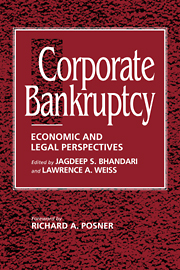Book contents
- Frontmatter
- Contents
- List of tables and figures
- Foreword by the HONORABLE RICHARD A. POSNER
- Preface
- Part I The role of credit
- Part II Bankruptcy as a reflection of the creditors' implicit bargain
- Part III Beyond the basic creditors' bargain
- 9 Bargaining after the fall and the contours of the absolute priority rule
- 10 On the nature of bankruptcy: An essay on bankruptcy sharing and the creditors' bargain
- 11 A simple noncooperative bargaining model of corporate reorganizations
- 12 Commentary on “On the nature of bankruptcy”: bankruptcy, priority, and economics
- 13 Bankruptcy and risk allocation
- 14 The corporate bankruptcy decision
- 15 Bargaining over equity's share in the bankruptcy reorganization of large, publicly held companies
- 16 Bankruptcy resolution: Direct costs and violation of priority of claims
- 17 The costs of conflict resolution and financial distress: Evidence from the Texaco-Pennzoil litigation
- 18 Survey of evidence on business bankruptcy
- Part IV Workouts or bargaining in the shadow of bankruptcy
- Part V Alternatives to bankruptcy and the creditors' bargain
- Part VI Experience of other countries
- Index
14 - The corporate bankruptcy decision
Published online by Cambridge University Press: 10 December 2009
- Frontmatter
- Contents
- List of tables and figures
- Foreword by the HONORABLE RICHARD A. POSNER
- Preface
- Part I The role of credit
- Part II Bankruptcy as a reflection of the creditors' implicit bargain
- Part III Beyond the basic creditors' bargain
- 9 Bargaining after the fall and the contours of the absolute priority rule
- 10 On the nature of bankruptcy: An essay on bankruptcy sharing and the creditors' bargain
- 11 A simple noncooperative bargaining model of corporate reorganizations
- 12 Commentary on “On the nature of bankruptcy”: bankruptcy, priority, and economics
- 13 Bankruptcy and risk allocation
- 14 The corporate bankruptcy decision
- 15 Bargaining over equity's share in the bankruptcy reorganization of large, publicly held companies
- 16 Bankruptcy resolution: Direct costs and violation of priority of claims
- 17 The costs of conflict resolution and financial distress: Evidence from the Texaco-Pennzoil litigation
- 18 Survey of evidence on business bankruptcy
- Part IV Workouts or bargaining in the shadow of bankruptcy
- Part V Alternatives to bankruptcy and the creditors' bargain
- Part VI Experience of other countries
- Index
Summary
A central tenet in economics is that competition drives markets toward a state of long-run equilibrium in which those firms remaining in existence produce at minimum average costs. In the transition to long-run equilibrium, inefficient firms (firms using obsolete technologies and those producing products that are in excess supply) are eliminated. Consumers benefit because in the long run, goods and services are produced and sold at the lowest possible prices. The legal mechanism through which inefficient firms most often are eliminated is that of bankruptcy. In 1984, around 62,000 business firms filed for bankruptcy. Two-thirds of them filed to liquidate in bankruptcy and the rest filed to reorganize in bankruptcy (Administrative Office of the U.S. Courts, 1985). The total liabilities of firms that filed for bankruptcy in 1985 came to approximately $33 billion (Dun & Bradstreet, 1986).
Economic theory suggests that bankruptcy should serve as a screening process designed to eliminate only those firms which are inefficient economically and whose resources could be better used in some other activity. However, firms typically file for bankruptcy voluntarily. When they do, creditors are not all repaid in full and large redistributional effects occur. Managers of firms do not take creditors' losses fully into account in deciding either how to run the firm or whether and when to file for bankruptcy. This suggests that firms in bankruptcy might not always be inefficient economically and that inefficient firms might not always end up in bankruptcy.
- Type
- Chapter
- Information
- Corporate BankruptcyEconomic and Legal Perspectives, pp. 207 - 231Publisher: Cambridge University PressPrint publication year: 1996
- 6
- Cited by



